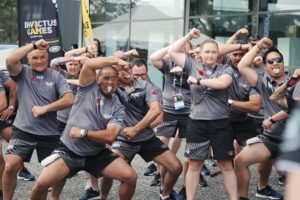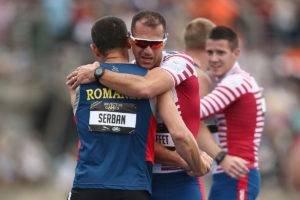Athletics
Athletics is one of the most popular sports of the Invictus Games. competitors challenge themselves over two days of track and field events at the Sydney Olympic Park Athletics Centre.
Sport Format

Competitors of all abilities may participate, including those competing in wheelchairs, with prostheses or under the guidance of a sighted person known as a guide. Events are divided by the functional categorisation of the competitors with events for men and women.
TRACK
Track events demand both speed and endurance, and cover distances from 100 to 1500 metres as well as the 4 x 100m mixed and women’s relays.
Competitors in the track events are allocated into one of seven categories.
- IT1 competitors have leg injuries and impairments equivalent to a below knee amputation to one or both legs. They are ambulant.
- IT2 competitors have leg injuries or impairments equivalent to above knee amputations. They run with a prosthesis if required.
- IT3 competitors have injuries or impairments in one or both of their arms. They are ambulant.
- IT4 competitors have injuries or impairments in their legs with some to full trunk control. They compete in wheelchair events.
- IT5 competitors have no trunk or leg function and compete in a wheelchair.
- IT6 competitors are blind or have low vision. Guide runners are optional for IT6 competitors.
- IT7 is the Open category and is for those competitors with mental health conditions, minor or non- permanent physical injuries, chronic health conditions, hearing impairments and other mild impairments.
FIELD
Field events include discus and shot put with long jump making its Invictus Games debut at Sydney.
Throwing Events
Competitors in discus and shot put are allocated into one of seven categories.
- IF1 competitors have leg impairments such as amputations or other injuries affecting their legs. They compete in a standing position.
- IF2 competitors have arm impairments such as amputations, nerve damage or other injuries to the arm. They compete in a standing position.
- IF3 competitors are blind or have low vision. They compete in a standing position and may use a guide to assist them during competition.
- IF4 is the Open category and is for those competitors with mental health conditions, minor or non- permanent physical injuries, chronic health conditions, hearing impairments and other mild impairments.
- IF5 competitors have leg impairments, such as amputations or other injuries and who deem themselves unable to compete in a standing position.
- IF6 competitors have leg and trunk impairments who are unable to compete in a standing position due to their injury.
- IF7 competitors have no use of their legs, and reduced use of their trunk and arms. They are unable to compete in a standing position due to their injury.
Long Jump
Competitors in the long jump are allocated into one of five categories.
- IJ1 competitors have leg injuries or impairments equivalent to below knee amputation in one or both legs.
- IJ2 competitors have impairments or injuries in their legs equivalent to above knee amputations.
- IJ3 competitors have injuries or other impairments in one or both of their arms.
- IJ4 competitors are blind or have low vision. Competitors are able to use a guide if required.
- IJ5 is the Open category and is for those competitors with mental health conditions, minor or non-permanent physical injuries, chronic health conditions, hearing impairments and other mild impairments.



